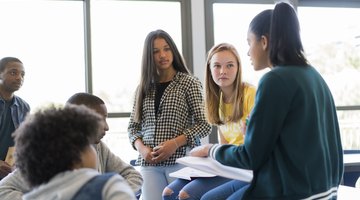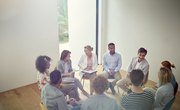While high school may seem like one giant sociology experiment, students can also conduct formal experiments in the science. Students who take sociology in high school often perform experiments as part of their course requirements or in conjunction with their science fair presentations. Experiment ideas should focus on the social lives of individuals or groups and how they function in society. Teenagers are in the process of developing their own perceptions of human nature and are often curious to discover how people respond or react to specific situations. As a student, you should always get your experiment approved by your teacher to ensure it's safe and beneficial to your understanding of sociology.
Deviant Behavior
Conduct an experiment that examines how society responds to deviant behavior or behavior that doesn't follow the norm. Ensure that the experiment neither violates laws or regulations nor poses any danger to those involved. For example, as a team of three, board a public elevator, such as one at a mall or a parking garage, and have one student face another, looking at the back wall rather than looking at the doors. A third student should stand at the back of the elevator, facing forward, and observe riders' reactions and responses to the rear-facing student. Don't block anyone's ability to get on or off the elevator or push the buttons, and limit your elevator use to a few minutes to avoid unwanted speculation. Another possibility would be to visit a public place, such as a park or a lounge area at the mall, and have one student eat an unusual item like a blue foot-long hot dog or a hot pink taco while the other student records bystander responses. The goal is to see how onlookers respond to out-of-the-ordinary behavior.
Honesty and Courtesy
Examine whether individuals are more likely to be honest and courteous when they know someone is watching them. One option might be to observe handicapped parking spots, without drivers knowing that you're watching the spaces, to see if those without handicap stickers still park there. Then, park next to the spaces or stand near them and observe if your visible presence deters ineligible drivers from parking in those spaces. You could conduct a similar experiment by spilling a handful of coins on the pavement and observing whether individuals return the money or pocket it. Examine if the response changes when others are present to witness the coin spilling. Record your observations.
Racial Discrimination
Perform an experiment to see if people respond differently to individuals of a different color or race. Pair up with a person of a different race, but the same gender, in your class. Dress in the same outfit and visit your local mall. Each person of the team should have another student follow him to document the responses. Record how long it takes customer service representatives or sales associates to address the similarly dressed students and document any differences in attitude, vocabulary or attentiveness. You might also document if the type of store made a difference, such as sporting goods stores versus cell phone stores or music stores.
Gender and Color Preference
Survey 100 males and 100 females and ask, "What's your favorite color?" You can limit your survey to a specific age group, such as high school students, or you can take a random poll of all ages. Record the answers and create a pie chart or a bar graph to summarize the responses. The goal is to see if the stereotypical association that girls like pink and boys like blue still holds true. The two colors weren't promoted as gender identifiers until just before World War I.
Related Articles
References
Writer Bio
As curriculum developer and educator, Kristine Tucker has enjoyed the plethora of English assignments she's read (and graded!) over the years. Her experiences as vice-president of an energy consulting firm have given her the opportunity to explore business writing and HR. Tucker has a BA and holds Ohio teaching credentials.











